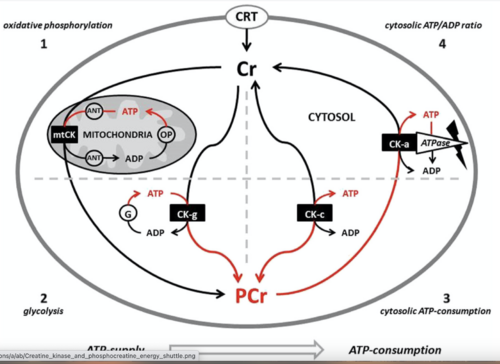Creatine Phosphokinase (CK or CPK)
Original Editor - Lucinda hampton
Top Contributors - Lucinda hampton, Kirenga Bamurange Liliane and Vidya Acharya
Introduction[edit | edit source]
Creatine phosphokinase (CPK) AKA creatine kinase (CK), is the enzyme that catalyzes the reaction of creatine and adenosine triphosphate (ATP) to phosphocreatine (PCr) and adenosine diphosphate (ADP). It is a reversible enzyme reaction that subsequently produces ATP from PCr and ADP. The PCr made is then used to supply tissues and cells that need substantial amounts of ATP, for instance the brain, skeletal muscles, and the heart, with this much needed ATP. Creatine phosphokinase (CK) is a major controller of homeostasis in cells. Numerous conditions cause disruption of CPK levels, including rhabdomyolysis, heart disease, kidney disease, and certain medications.[1]
CK in Blood Tests[edit | edit source]
The appearance of CK in blood tests is usually considered an indirect marker of muscle damage, especially for diagnosis of medical conditions such as myocardial infarction, muscular dystrophy, and cerebral diseases (eg injuries and infections to the brain, brain tumors and dementia).
- Naturally muscle cells will release CK as a part of day to day life. Certain people eg certain ethnic groups, fit men with larger muscles have naturally a higher normal CK level than other people (for example older women).
- Heavy exercise can cause higher CK levels, as well as muscle damage caused by eg a fall, an injection into a muscle, road trauma, surgery. Some drugs, particularly cholesterol-lowering drugs (statins), can damage muscle and increase CK.[2]
- The molecular mechanisms causing CK release from muscle after mild exercise remains unclear. Clarification would help give important information for those concerned about muscle hypertrophy, performance, and the significance of rest periods between periods of exercise.[3]
Not all exercise creates the same CK response. A large increase in plasma creatine kinase has also been shown after eccentric loading, however only a small increase in CK levels in the blood after concentric loading occurs. In some medical conditions (eg myositis, muscular dystrophy) were elevated CK levels is a feature concentric exercise should be considered over eccentric exercise.[4]
Sub Heading 3[edit | edit source]
Resources[edit | edit source]
- bulleted list
- x
or
- numbered list
- x
References[edit | edit source]
- ↑ Aujla RS, Patel R. https://www.ncbi.nlm.nih.gov/books/NBK546624/ StatPearls. Treasure Island (FL).Available:https://www.ncbi.nlm.nih.gov/books/NBK546624/ (accessed 4.2.2024)
- ↑ Pathology tests explained. CK Available at:https://www.pathologytestsexplained.org.au/ptests-pro.php?q=Creatine%20kinase%20(CK) (accessed 5.2.2024)
- ↑ Baird MF, Graham SM, Baker JS, Bickerstaff GF. Creatine-kinase-and exercise-related muscle damage implications for muscle performance and recovery. Journal of nutrition and metabolism. 2012 Oct;2012.Available:https://www.ncbi.nlm.nih.gov/pmc/articles/PMC3263635/ (accessed 5.2.2024)
- ↑ Koller A, Müller E, Artner-Dworzak E, Haid C, Schobersberger W, Puschendorf B, Raas E. Metabolic Changes Following Concentric and Eccentric Exercise in Trained and Untrained Subjects. InAdvances in Ergometry 1991 (pp. 406-409). Springer Berlin Heidelberg. Available:.https://link.springer.com/chapter/10.1007/978-3-642-76442-4_57 (accessed 5.2.2024)







